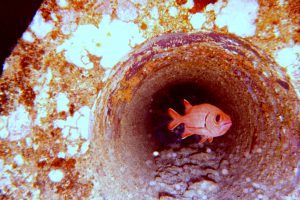Dr. Alison Robertson, an NCCOS ECOHAB sponsored ciguatera expert with the University of South Alabama and Dauphin Island Sea Lab (USA\DISL), is helping the NOAA Office of National Marine Sanctuaries (ONMS) assess human health threats related to ciguatera fish poisoning in islandwaters within the Papahanaumokuakea Marine National Monument (PMNM). Ciguatera is a major, if not the leading, cause of non-bacterial food poisoning in the U.S., but lacking are modern studies on the presence and prevalence of ciguatera in the Northwestern Hawaiian Islands.

The Hawaiian Archipelago including Papahānaumokuākea Marine National Monument. Credit: Office of National Marine Sanctuaries, NOAA National Ocean Service
In 2015, the ONMS supported Dr. Robertson to initiate a pilot study to better understand the ciguatera toxicity levels in fish collected from Nihoa Island (about 160 miles Northwest of Kaua'i) and Kure Atoll (at the extreme NW end of the Hawaiian archipelago). This study supplemented past researchdocumenting ciguatera levels throughout the region. The team shipped select reef fish, collected at Nihoa and Kure, to the Robertson Lab for ciguatera toxin (CTX) analysis.

Kole tang, yellow-eyed tang, or spotted surgeonfish (Ctenochaetus strigosus, Acanthuridae). Credit: North Carolina Aquarium at Ft. Fisher
Dr. Robertson reported her findings to PMNM managers last fall and recently shared her results with staff at the NOAA Inouye Regional Center in Honolulu. Fish samples from Nihoa showed unexpectedly high levels in CTX toxicity in 'ūʻū (Myripristis berndti), a soldier/squirrel fish that is prized in Hawaiʻi and Pacific Island nations as a subsistence and culturally important food. Findings of consistently high prevalence of CTX in kole (Ctenochaetus strigosus), a surgeonfish traditionally speared, fried and eaten whole, were consistent with findings in some areas of the main Hawaiian islands.
Dr. Robertson also developed and shared a method of categorizing findings based on the risk of getting ciguatera fish poisoning from eating tainted fish. Based on CTX level variability in ʻūʻū samples, this species was determined a very high-risk species, calling into question the general belief that this fish is typically safe to consume. Kolewas also deemed risky but it was noted that toxicity levels in these fish can vary from place to place. Dr. Robertson is continuing to refine arisk scale, but PMNM managers indicated it is a useful tool as they consider how to better understand and address this issue.

The bigeye squirrelfish, menpachi, or 'ūʻū (Myripristis berndti, Holocentridae). Credit: NOAA Photo Library
This effort has prompted renewed interest within the Native Hawaiian community about ciguatera fish poisoning, and the Office of Hawaiian Affairs, a PMNM co-trustee, supports limited additional fish collection for ciguatera analysis. Staff and scientists at NCCOS, NOAA Fisheries, OMNS, University of Hawaii, and other PMNM co-trustee representatives continue to explore alternative research needed to develop safe and effective management policies.
For more information, contact Marc Suddleson.
 Official websites use .gov
A .gov website belongs to an official government organization in the United States.
Official websites use .gov
A .gov website belongs to an official government organization in the United States. Secure .gov websites use HTTPS
A lock or https:// means you’ve safely connected to the .gov website. Share sensitive information only on official, secure websites.
Secure .gov websites use HTTPS
A lock or https:// means you’ve safely connected to the .gov website. Share sensitive information only on official, secure websites.